Great Blue Heron Ardea herodias
The largest heron found along the St. Lawrence River and lakes near Montreal. When not resting, the bird either stands still in the water or moves slowly along the shores searching for frogs, snakes or fishes to catch.
Specs
| Length | 90-100cm |
| Weight | 2-3kg |
| Wingspan | 160-180cm |
Common Names
| German | Kanadareiher |
| English | Great Blue Heron |
| French | Grand Héron |
| Spanish | Garza Azul |
Taxonomy
| Order | Pelecaniformes |
| Family | Ardeidae |
| Species | Ardea herodias |
Advertisement
We need your help! By making a contribution towards our hosting costs, you can help us provide an ad-free experience on our website in the near future. Paypal
How to Identify
It's the largest heron seen in Montreal. Mostly grey with some white along the head. It can be easily distinguished from the slightly smaller heron, the Great Egret which is completely white.
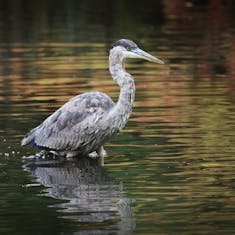
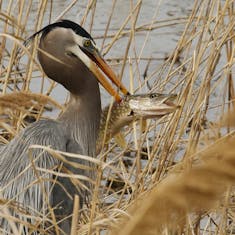
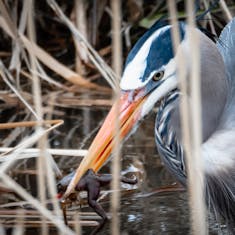
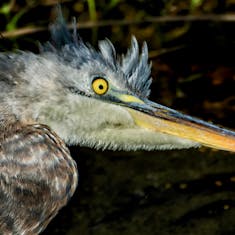
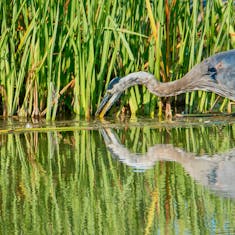
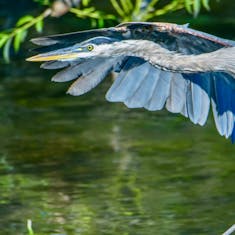
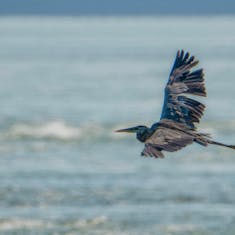
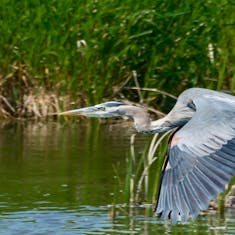
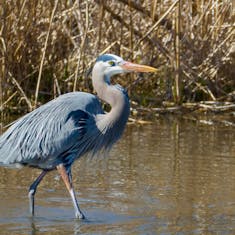
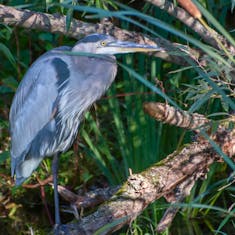
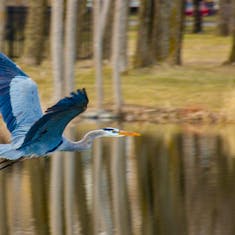
Great Blue Heron Trivia
Is the Great Blue Heron the largest heron species in North America?
Indeed, this magnificent wading bird stands tall, typically ranging from 90 to 140cm in height, with a wingspan that can extend up to an impressive 180cm.
Is the Great Blue Heron a carnivore?
Yes, it is indeed a carnivore. Its diet primarily consists of fish, but this species also preys on frogs, salamanders, turtles, snakes, insects, rodents, and even other birds.
Is the Great Blue Heron a nocturnal bird?
No, it is primarily active during the day but may also feed at dawn or dusk when prey is more abundant or less alert.
Does the Great Blue Heron hunt alone?
Yes, it does. This species can often be observed hunting alone, typically standing motionless on a branch or stone protruding from the water, or wading along coastlines, in marshes, or near the shores of ponds or streams.
Is the Great Blue Heron a territorial bird?
Yes, this bird species defends its feeding and nesting areas from intruders. It may use vocalizations, postures, or even physical attacks to deter rivals or predators.
Is the Great Blue Heron a vocal bird?
No, this bird species does not produce many sounds. It is mostly silent, except for some harsh croaks or squawks when disturbed or in flight.
Is the Great Blue Heron a monogamous bird?
No, it is not a monogamous bird in the sense of mating with only one partner for life. However, during the breeding season, it does form pair bonds with a mate. These pair bonds are temporary and typically last for the duration of the breeding season.
Is the Great Blue Heron a good parent?
Yes, it is indeed a dedicated parent and exhibits strong parental care behaviors. Both parents collaborate in building the nest, incubating the eggs, and providing food for the chicks once they hatch until they are ready to fledge.
Is the Great Blue Heron a migratory bird?
Yes. Most populations of this species are migratory, although some are resident year-round. The migratory ones breed in Canada and the northern United States and winter in Central America and the Caribbean.
Is the Great Blue Heron an endangered species?
No, this bird species is not at risk of extinction. However, one subspecies, the Pacific Great Blue Heron, is considered of special concern in Canada due to habitat loss and human disturbance. (see references)
Does the Great Blue Heron nest in trees?
Yes, this bird species prefers tall trees for nesting. However, sometimes it nests in low shrubs or on the ground if no suitable trees are available.
Does the Great Blue Heron have a long lifespan?
Yes, it does. The average lifespan of a Great Blue Heron in the wild is 15 years, but some individuals have been recorded to live up to 24 years.
Where and When to Spot
Usually found moving slowly within the reed, or it stands on wood trunks or stones in flowing water. Can be seen from early spring to late autumn as long as the shores of river and lakes are not frozen. Migrates South late autumn.
| Spring | Summer | Fall | Winter | |
|---|---|---|---|---|
| Parc Angrignon | x | x | x | - |
| Parc Bernard-Landry | x | - | - | - |
| Parc Michel-Chartrand | x | - | - | - |
| Parc de la Frayère | x | x | - | - |
| Parc des Rapides | - | x | x | - |
| Saguenay St. Lawrence Marine Park | - | x | - | - |
Where and when a species has been observed, identified, and recorded.
